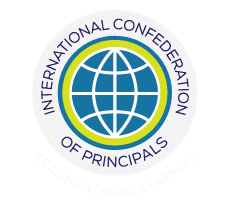One of my all-time greats is Sir Ken Robinson; simply because I reckon he and I would always get along really well when discussing education over a beer. He’s renowned for many a stirring quote and one that I fondly recall that shaped my own career as a Principal is …
“The role of a creative leader is not to have all the ideas; it’s to create a culture where everyone can have ideas and feel they’re valued.”
The International Confederation of Principals advances this notion and supports creative leaders all around the globe. ICP is especially good at linking these leaders and cultivating opportunities where ideas are shared and learning together promotes further innovation. Our ICP mantra ‘’Leading, Linking, Learning’ says it all. In this ICP Blog, I want to share a short story about a new ICP fostered research project; one that stems from our Strategic Plan priorities which includes initiating small research activities. This story is about one creative school Principal who is being nurtured by ICP and an international partner, the Ed Institute, to create a culture in the school and indeed, within the whole community, where everyone can have ideas and feel they’re valued (https://edinstitute.com.au/). This example, of a Principal leading change in their community, isn’t unique around the world but, in these ‘unprecedented times’, this Principal is grasping an opportunity where others might think being submersed in ‘doing school’, albeit remotely, was enough to take on. This collaboration also represents a real example of what Maria Doyle (ICP Executive) detailed in the last ICP blog about the importance of ‘Networking’.
The community which this Principal leads, has been ravaged by drought, bushfires and Covid-19 pandemic restrictions, just to name a few of the recent challenges faced by the people who live there. The town has a declining population, diminishing services, and there are numerous fourth and fifth generation welfare families. Few parents have tertiary education qualifications with many having achieved only Year 9 level and this was undoubtedly realized at the local school. There is little by way of employment opportunities for students with many school graduates, leaving with at least 2 years of formal education still available to them, who are mainly encouraged into service roles or career paths like their parents. Mental health challenges are clearly apparent for members of the staff team, increasing amongst the student cohort, and are a formidable presence in the wider community. Access to any health support is very limited and often available only some distance away. Despite this pained portrayal, there is a strong spirit in the community but unfortunately the pre-eminent sense is still one of low expectation and aspiration.
The school is small and remotely situated in NSW Australia. It is about 100 klms to any ‘nearby’ large town or city. It has a student cohort of just over 100 enrolled across all academic years from Kindergarten to Year 12. The Index of Community Socio-Educational Advantage for the school is very low compared to a national average of 1000 identifying the school and community as significantly disadvantaged. Approximately 92% of students rate in the bottom half of Socio-Educational Advantage and only 2% of students rank in the top quartile of this measure. There are about 20 (16%) Indigenous students.
This Principal is an experienced school leader but with just under five years at this school. She has previously provided leadership in system-level settings and has authored texts in areas of teaching and learning, especially around Literacy. The small executive team is inexperienced but mostly positive about their work. However, their demeanour and language tends to reinforce the perception that ‘these kids can’t do high-level schooling’. The various capabilities of staff, or lack thereof, constrain significant growth in student achievement generally, however, the teachers are kind, caring and genuinely interested in the students’ wellbeing. The Principal, by having a really ‘hands-on’ leadership approach during her first few years at the school has reshaped the teaching of literacy skills, especially in the early secondary school context, to improve outcomes as measured in the ‘National Assessment of Literacy and Numeracy’ testing. Another positive characteristic she has inspired is for teachers to regularly share fabulous stories of successful children and young people who are luminaries as graduates of the school. She is also very much aware of the value to be realised through ‘networking’.
No doubt, this school, the teachers, children and young people, and indeed, the whole community, are fortunate to have this Principal in their midst. She is one who holds dear the notion of ‘Equity’, which has also been at the forefront of ICP’s endeavour over many years. She is the one, who in partnership with ICP and the Ed Institute team, will drive a revitalization in this community where people live, work, study and play, but who are casualties of inequity. Undeniably, an exacting adventure lies ahead for this creative leader.
On the Ed Institute website, they profess… “At the Ed Institute, we recognise young people as the next generation of leaders, change makers, innovators and disruptors.” This team brings a Design Thinking process to the collaboration, a process that will help the Core Design Team focus upon developing a sound understanding of the complex issues facing the community and the school. The work will include spending time talking with the students, school and community leaders, as well those key community members who have had either significant success or deep disappointment, to gauge what perspectives they hold about the past, present and future. The emphasis will be on understanding the impacts of experiences such as those described earlier in this blog and, the lack of opportunity, aspiration and expectation afforded to and held by the young people in particular. The plan is for the voice of the young people to inform the shaping of a new and different future for the town, for themselves, and their children, and their grandchildren. The students will be the generational change-makers.
Perhaps the moral of this story is that in every crisis, there is an opportunity. At least, this is how this creative leader sees the current global pandemic. This blog really just is about the start of a much longer story. In fact, we may never tell the ending. We do hope that the narrative that we compose along the way will inspire other creative leaders to help their communities to see a better future. ICP plan to provide a ‘playbook’ that can inspire and inform other leaders to help forge a pathway to a more prosperous future.
But for now, as this expedition begins for this Principal, for ICP, and for the Ed Institute team, it is a matter of us noting another of Sir Ken’s provocations;
“For most of us the problem isn’t that we aim too high and fail. It’s just the opposite: we aim too low and succeed.”
and take the inherent lesson, ‘We must aim high’!


